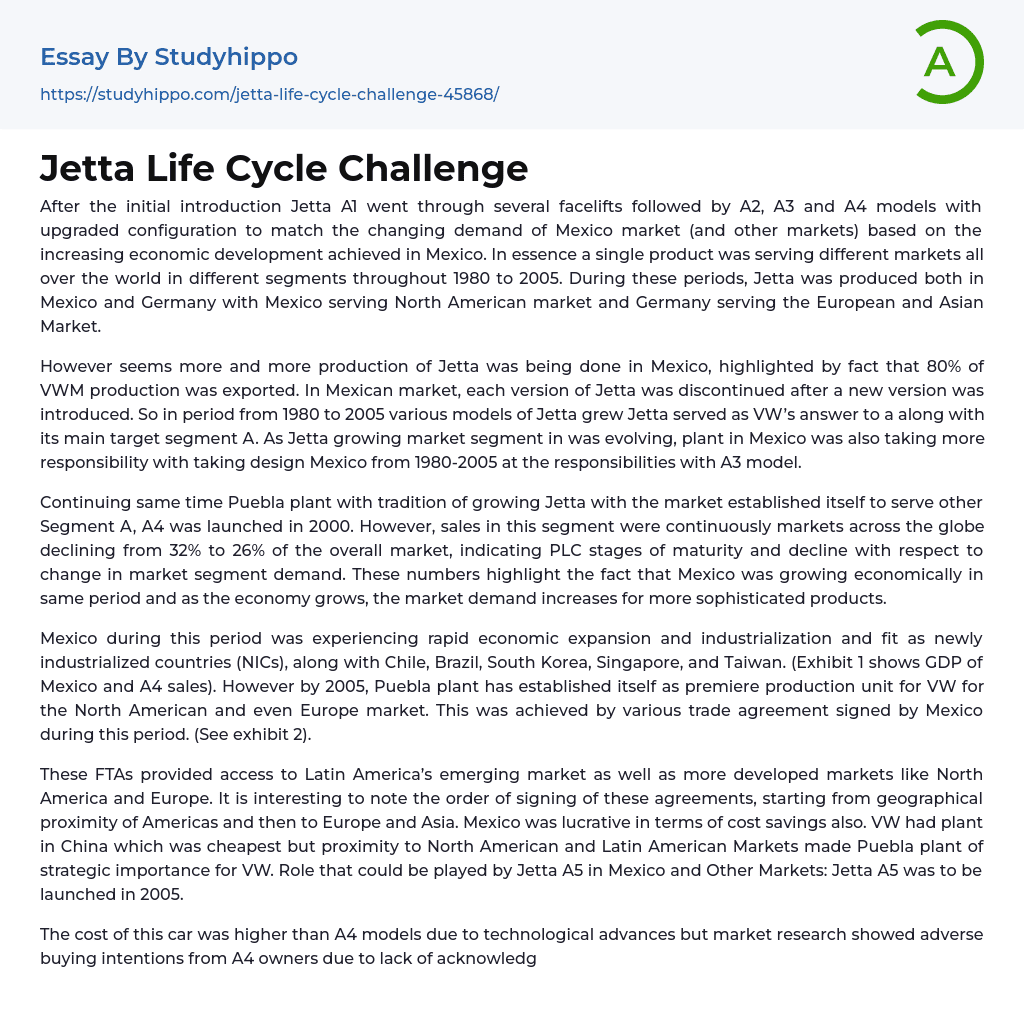The Jetta A1 received several updates (such as the A2, A3, and A4 models) to meet the evolving needs of the Mexican market and other global markets. This was a result of Mexico's growing economic development. From 1980 to 2005, the same product was used in different segments across multiple markets worldwide. The Jetta was manufactured in Mexico primarily for North America and in Germany for Europe and Asia.
It seems that a larger proportion of Jetta production was happening in Mexico, as indicated by the fact that 80% of VWM production was being exported. In the Mexican market, each Jetta version was discontinued when a new version came out. Therefore, from 1980 to 2005, different Jetta models were introduced to cater to the expanding market segment it targeted. Throughout this period, the Mexican plant assumed more tasks, includi
...ng designing for the A3 model.
The Puebla plant has a history of producing the Jetta model for the Segment A market. However, in 2000, the A4 model had to be introduced due to a global decrease in sales within this segment. Currently, the Segment A market only represents 26% of the total market share, compared to its previous share of 32%. These statistics suggest that demand for this segment is declining as it matures. It's worth noting that Mexico's economy grew during this time, leading to a higher demand for more advanced products.
Mexico, along with Chile, Brazil, South Korea, Singapore, and Taiwan, experienced significant economic growth and industrialization during a period of time. This led to its classification as one of the newly industrialized countries (NICs). The Puebla plant became Volkswagen's main production facility
in both North American and European markets by 2005. Mexico's trade agreements during this time played a crucial role in making this achievement possible.
The Free Trade Agreements (FTAs) allowed entry into Latin America's emerging market as well as more developed markets like North America and Europe. It is important to note that these agreements were signed in a specific order, with priority initially given to the Americas and later expanding to Europe and Asia. Additionally, Mexico offered distinct advantages due to its cost-effectiveness. Despite having a factory in China with the lowest expenses, Volkswagen highly valued the strategic location of its Puebla plant near the North American and Latin American markets. The upcoming introduction of the Jetta A5 in 2005 presented significant opportunities for both Mexican and international markets.
The A5 model's higher cost compared to the A4 models can be attributed to the inclusion of technological advances. However, market research has shown that owners of A4 models are reluctant to purchase the car because they do not recognize these upgrades and are unwilling to pay a higher price. In order to maintain profits, it is necessary to attach a higher price tag to the A5 model. If Jetta offers both the A4 and A5 models and targets segment A with both, there is a risk of cannibalizing sales. Therefore, in this situation, the optimal approach is to continue producing the A4 model for segment A while also introducing production of the A5 model and targeting segment B.
Market research indicates that segment B sales have experienced a temporary decline, but are projected to increase in the future as a result of the launch
of a new brand in Mexico and the robust Mexican economy. The data further reveals that numerous current car owners who possess segment B or A4 models are likely to switch to the A5 model, with 23% transitioning from the A4 model specifically. It is expected that there might be some sales overlap between the A4 and A5 models due to their positions in the current stage of the product life cycle for the A4.
There is evidence suggesting that many non A4 car owners in Mexico view the prototype as being worth a price comparable to Segment B. Although the A4 model is in the maturity and decline stages of its product life cycle, it is still a profitable model. If the A5 model is targeted towards segment B, the A4 can still be successful in segment A. It is recommended that VW discontinues unprofitable variations of the A4 and competitively prices their vehicles to outperform rivals in the Mexican market. Additionally, reducing advertising efforts will help maintain loyal customers. Latin American markets, as indicated in Chapter 9 slides, are currently considered big emerging markets (BEMs).
- Family essays
- Wealth essays
- Punctuality essays
- Carpe diem essays
- Persistence essays
- Chicken essays
- Crops essays
- Object essays
- Adaptation essays
- Love Story essays
- Mystery essays
- Thank You essays
- Hero essays
- Farm essays
- Focus essays
- Development essays
- Welding essays
- Nursing essays
- Integrity essays
- Hypocrisy essays
- Mother Tongue essays
- Contrast essays
- Secret essays
- First Love essays
- Motherhood essays
- Beauty essays
- Alcohol essays
- Aging essays
- Narcissism essays
- Myself essays
- Greed essays
- Limitations essays
- Fire essays
- House essays
- Peel essays
- Evil essays
- Humility essays
- Perspective essays
- Dream essays
- Change essays
- Choices essays
- Toys essays
- Experience essays
- Wisdom essays
- Transport essays
- Barbie Doll essays
- Adversity essays
- Lifestyle essays
- Housing essays
- Holiday essays




